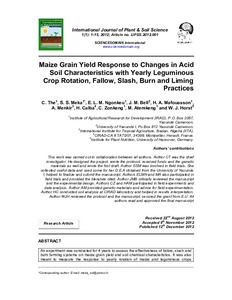| dc.contributor.author | The, C. |
| dc.contributor.author | Meka, S. |
| dc.contributor.author | Ngonkeu, E. |
| dc.contributor.author | Bell, J.M. |
| dc.contributor.author | Mafouasson, H.A. |
| dc.contributor.author | Menkir, A. |
| dc.contributor.author | Calba, H. |
| dc.contributor.author | Zonkeng, C. |
| dc.contributor.author | Atemkeng, M. |
| dc.contributor.author | Horst, Walter J. |
| dc.date.accessioned | 2019-12-04T11:08:23Z |
| dc.date.available | 2019-12-04T11:08:23Z |
| dc.date.issued | 2012-12 |
| dc.identifier.citation | The, C., Meka, S., Ngonkeu, E., Bell, J.M., Mafouasson, H.A., Menkir, A., ... & Horst, W.J. (2012). Maize grain yield response to changes in acid soil characteristics with yearly leguminous crop rotation, fallow, slash, burn and liming practices. International Journal of Plant & Soil Science, 1(1), 1-15. |
| dc.identifier.issn | 2320-7035 |
| dc.identifier.uri | https://hdl.handle.net/20.500.12478/1809 |
| dc.description | Open Access Journal |
| dc.description.abstract | An experiment was conducted for 4 years to assess the effectiveness of fallow, slash and burn farming systems on maize grain yield and soil chemical characteristics. It was also meant to measure the response to yearly rotation of maize and leguminous crops (cowpea and mucuna), as options for managing the acidity of the soil of the study site. The maize tolerant cultivar (cvr) out yielded the sensitive cvr and the farmers’ variety by 43% and 16% respectively. On the maize/grain legume rotation plots, the tolerant and sensitive cvr yielded 5% and 7% respectively more than their corresponding yields on plots with fallow, slash and burn rotation. Maize/grain legume rotation demonstrated one of the least soil acidifications, exhibiting the least increase in exchangeable Al (23%), H (24%), and Al saturation (5%) resulting in improved soil fertility through increase in available Ca (2%), Mg (85%), P (75%), and CEC (14%). The fallow, slash and burn rotation, associated with the tolerant cvr showed similar grain yield with grain legume rotation, but contributed more to soil acidification. Maize/leafy legume rotation gave a similar yield to the above mentioned practices. The yearly application of 250 kg ha-1 of dolomitic lime for four consecutive years did not result in significant changes in soil characteristics and grain yield especially for the Al tolerant cvr. However, application of 2250 kg ha-1 of lime neutralized the Al toxicity, regardless of the rotation scheme. The study concluded that the four years maize cultivation through fallow/ slash and burn rotation extensively used in the humid forest zone is not the best option on acid soil. |
| dc.description.sponsorship | European Union |
| dc.format.extent | 15-Jan |
| dc.language.iso | en |
| dc.subject | Acid Soil |
| dc.subject | Leguminous Crops |
| dc.subject | Lime |
| dc.subject | Maize |
| dc.subject | Rotation |
| dc.subject | Slash |
| dc.subject | Burn |
| dc.title | Maize grain yield response to changes in acid soil characteristics with yearly leguminous crop rotation, fallow, slash, burn and liming practices |
| dc.type | Journal Article |
| dc.description.version | Peer Review |
| cg.contributor.crp | Maize |
| cg.contributor.affiliation | Institute of Agricultural Research for Development, Cameroon |
| cg.contributor.affiliation | Université de Yaoundé |
| cg.contributor.affiliation | International Institute of Tropical Agriculture |
| cg.contributor.affiliation | Universität Hannover |
| cg.coverage.region | Africa |
| cg.coverage.region | West Africa |
| cg.coverage.country | Cameroon |
| cg.authorship.types | CGIAR and developing country institute |
| cg.iitasubject | Maize |
| cg.iitasubject | Agronomy |
| cg.iitasubject | Farming Systems |
| cg.journal | International Journal of Plant & Soil Science |
| cg.howpublished | Formally Published |
| cg.accessibilitystatus | Open Access |
| local.dspaceid | 83261 |

